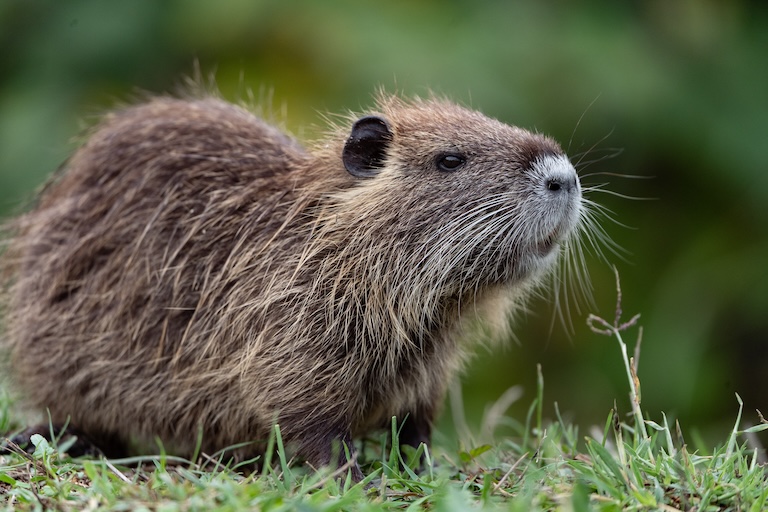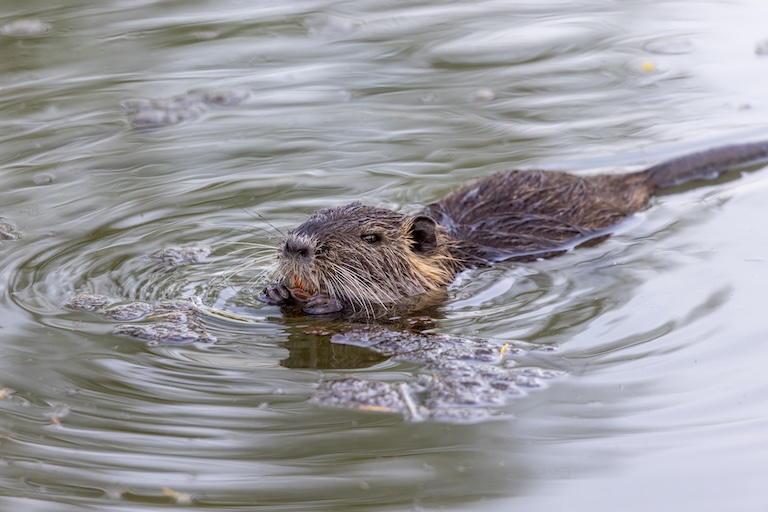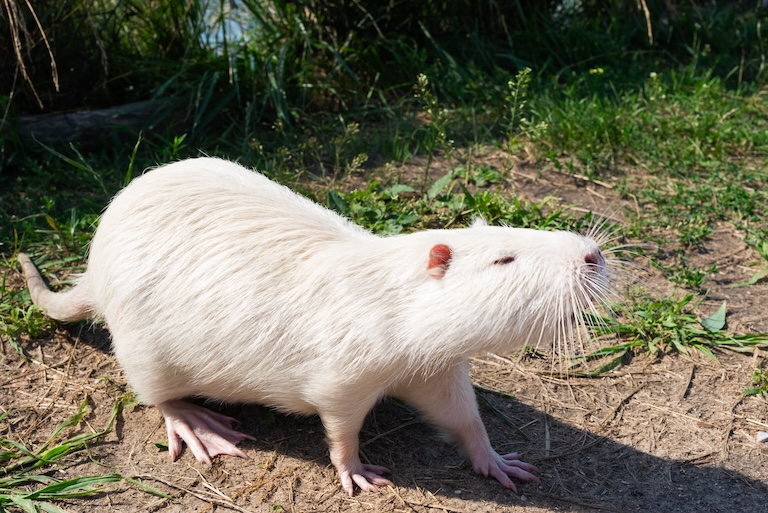Nutria Profile
On the banks of the river, at almost any non-arctic location in the Northern Hemisphere, there’s a species of rodent that seems to have taken bits of inspiration from various other members of its order to create a mismatch of qualities that render it an unstoppable force of nature.
This Frankenstein’s rodent has a bit of everything: rat, beaver, mouse, even otter, and it’s using it to take over the world.

Nutria Facts Overview
| Habitat: | Banks of freshwater riverways |
| Location: | Native to South America, introduced to North America and Europe |
| Lifespan: | Up to 4 Years, usually 3 |
| Size: | Up to 60cm (24 in) with a 45 cm (18 in) tail |
| Weight: | Around 9 kg (20 lb) |
| Colour: | Dark brown |
| Diet: | Aquatic vegetation, some invertebrates |
| Predators: | Alligators, garfish, bald eagles, other birds of prey, turtles, cottonmouths, various mammal predators, humans |
| Top Speed: | Deceptively nippy on the ground, faster in the water |
| No. of Species: | 1 |
| Conservation Status: | Least Concern (IUCN) |
Nutria, or Coypu have a generic name that belies the confusion around what exactly they are.
These “mouse beavers” are tenacious rodents; despite being widely persecuted for their fur, their meat, and the damage they cause to wetlands, they’re doing exceptionally well, especially in areas where they shouldn’t.
They’re smart, social, and excellent swimmers, but they breed like crazy and it can be hard to control a population once it gets established in the wrong place.
Interesting Nutria Facts
1. They’re a bit of everything
Nutria, or coypu, don’t have a very useful common name to give you an idea of what they are, but their generic name is also a bit ambiguous. Myocaster translates to “mouse beaver”, and this is a fairly good descriptor, though it’s technically neither.
Nutrias look like large rats, or beavers without the flattened tails. They’re larger than any rat you’d hope to find, at up to 17kg in exceptional individuals, but are typically smaller than beavers, with a rat-like tail.
They have three sets of fur and bright orange incisors, which also brings the muskrat into the fray of look-alikes, but the muskrat is smaller and can be found in colder regions than the nutria will tolerate. Muskrats also have flattened tails, unlike the nutria’s ratty appendage.
To add to the confusion, the name Nutria is from the Spanish word for otter, which is not even a rodent.
The word coypu seems to be the least ambiguous name there is for this animal and derives from a native language and the word for this species. 1

2. They’re good in the water
Coypus most definitely are rodents, and they most definitely are well equipped for the water. While they don’t have the flattened paddle tail of some aquatic rodents, they have large, powerful hind legs used for propulsion.
The ears and eyes are set high up on the head to peer from beneath the surface and the nose can be closed while submerged.
They can hold their breath for five minutes, and construct platforms of plant material in the water from which they hunt and breed. And they are very good at breeding. 2
3. They live fast, die young
Nutria live in large colonies. A single den will contain around four of them, and there may be many dens around. Females reproduce a lot, with up to three litters of up to seven young each year, meaning each den can produce up to 63 new nutria in a year.
This fast reproduction reflects a fast lifestyle, and each nutria will need to eat about 25% of its body weight in food every day. This can even be pushed to more, and a large and particularly hungry individual might get through 10kg of roughage.
This strategy comes at a cost (or perhaps out of a sense of urgency) because the animals themselves rarely live more than three years in the wild.
4. They’re highly adaptable
These rodents therefore breed quickly and radiate into various aquatic habitats with ease. They’re tough and adaptable animals, commonly found very comfortably in farm ponds, swamps, marshes, fresh or brackish waters, and more or less any other aquatic environment that isn’t too cold.
They love the boundaries of land and water, where there is the highest abundance of plant material. Freshwater marshes and rivers are the best for this.
The thick and complex fur that they wear protects them from a lot of environmental stress but has also drawn attention to them as a source of clothing.
5. They’ve been farmed for fur
On the outside, these rodents look shaggy and unkempt. But the inner that keeps them warm is dense and fine.
In the 1930s several top-tier Hollywood celebrities made the first popular. Imports to the United States increased by the 1950s when they were farmed extensively for fur.
Escapes from these fur farms made it to the swamps of Louisiana where their populations exploded and began to threaten the ecosystem. 3

6. They can be a pest
It wasn’t just America that struggled with this problem. European fur farms also let the prisoners out and they are now widespread across much of the northern hemisphere.
Nutria not only eat a lot but they do so all year round and conservation efforts are now intensifying to reduce the damage.
In the UK, this problem began as early as 1932. In the early 60s, almost 100,000 Nutria were licensed for removal, and around half of this was achieved. Immediately after the campaign ended, the animals promptly returned.
A second program was initiated in the late 80s with a bit more success and the species was listed as eradicated by 1989. 4
7. Or a meal
One approach to the overpopulation problem is to get the public on board. With nutria fur no longer in fashion, governments turned to the public’s desire for meat.
Cookbooks emerged, with recipes for nutria and information on how to trap, prepare and clean them. Nutria meat was deemed among the healthiest to consume. 5
Nutria Fact-File Summary
Scientific Classification
| Kingdom: | Animalia |
| Phylum: | Chordata |
| Class: | Mammalia |
| Order: | Rodentia |
| Family: | Echimyidae |
| Genus: | Myocastor |
| Species: | M. coypus |
Fact Sources & References
- “The Biology of Nutria”, Nutria.
- “Nutria Biology”, Internet Center for Wildlife Damage Management.
- “Nutria”, National Geographic.
- (1999), “Modeling the effects of nutria(Myocastor coypus) on wetland loss”, Springer Nature Link.
- Author Name (Year), “Article Name”, Publication.
